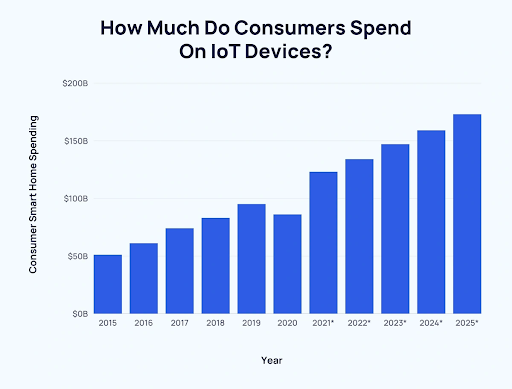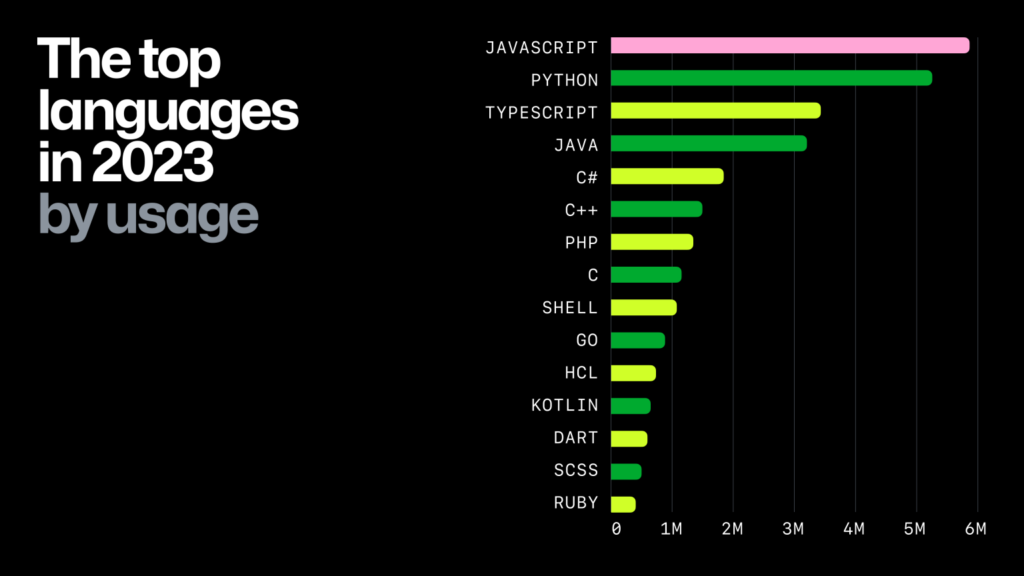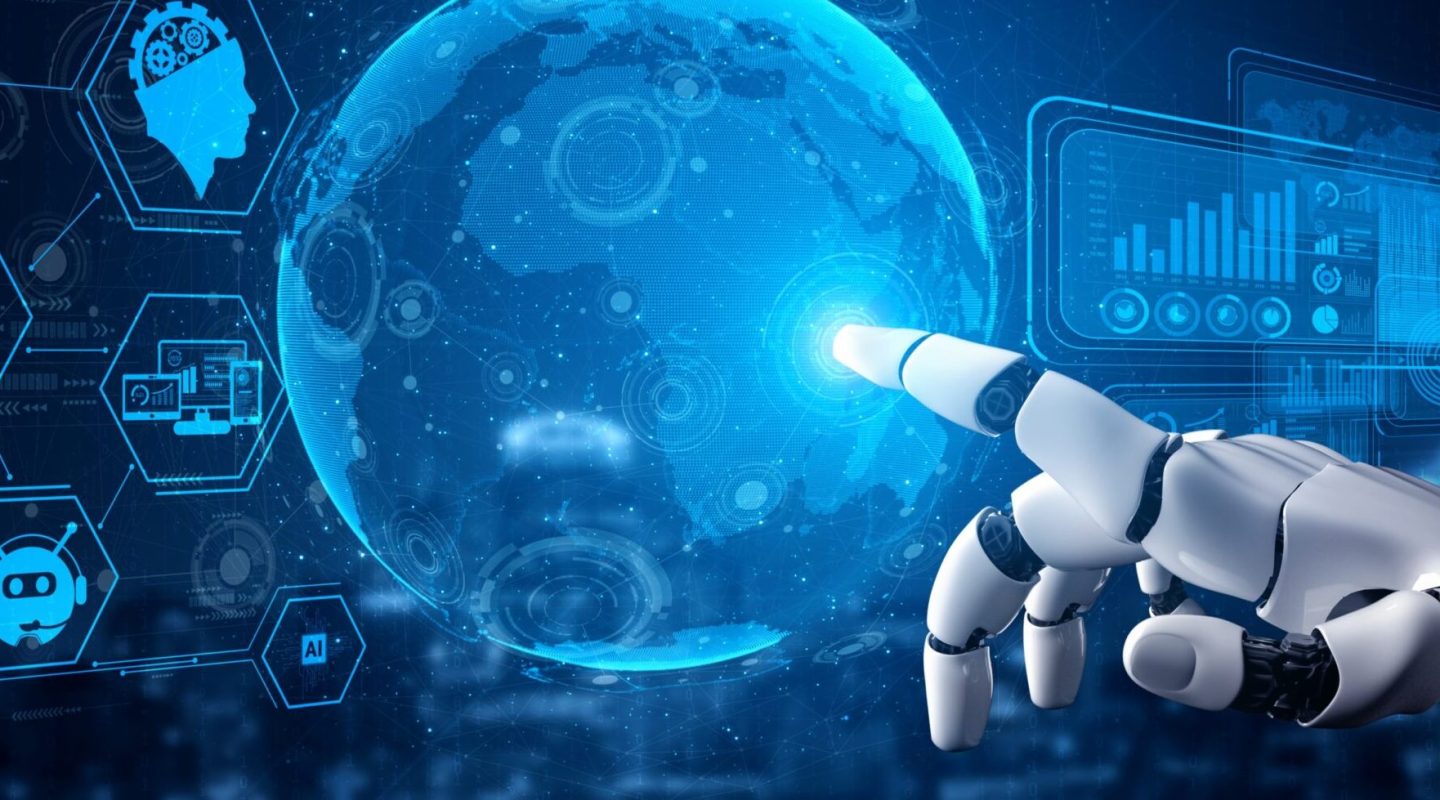Welcome back! In the first part of our exploration into the key software development trends for 2024-2025, we discussed everything from global conceptual trends to the specifics of crypto development. Now, let’s continue our journey into the exciting realms of IoT, Architecture, UX/UI and omnichannel-focused development, and beyond.
We’ll see how these technologies are being integrated into everyday computing and how they’re set to transform the way we interact with digital environments. From the rise of mobile-first approaches to the expansion of cross-platform app development frameworks, the next phase of software development is here.
Software Development for IoT Continues to Evolve
More than 10% of venture capital funding is related to IoT, Internet of Things products. The global IoT device market is expected to grow at an average annual rate of 16.7%, reaching over $650.5 billion by 2026. Consumer spending is anticipated to continue its upward trajectory through 2025, increasing year over year and peaking at $173 billion.
Specifically, voice processing for voice-first apps and voice control programming are set to advance significantly, thanks to the impact of GPT-4o as described above.


Software Development for Augmented Reality (AR/VR/MR/XR) and Metaverses
These technologies are transforming the e-commerce and education industries. The announcement of the Apple Vision Pro mixed reality headset in 2023 is expected to spur further ecosystem development around it in the coming years.
Cloud-Based Software Solutions and Distributed Computing: Enhancing Software Development
Incorporating cloud features into software coding has become crucial for optimizing development processes. Cloud applications play a significant role in reducing operational costs and improving efficiency.
Distributed computing is gaining traction, allowing multiple servers to work together to handle larger data sets and complex processing tasks more efficiently. This method not only speeds up operations but also enhances scalability and reliability.
The benefits are clear:
- Speed and power from harnessing multiple computers.
- Cost efficiency by reducing reliance on centralized systems.
- Reliability with no single point of failure.
The increasing adoption of distributed cloud services indicates a move towards more sophisticated and scalable computing solutions, essential for modern business needs.
As cloud computing continues to evolve, especially with deep learning models training demanding substantial resources, the demand and prices for distributed computing capabilities are rising.

Software Solutions Architecture Enhancements
Microservices Architecture and Containerization
Microservices architecture is poised for significant growth in 2024, evolving into more versatile multitasking configurations. This strategy, termed MACH, enables services to be crafted in multiple programming languages and implemented across varied environments, boosting customization and efficiency.
Containerization, particularly through platforms like Docker, has revolutionized application deployment, enabling scalability and operational efficiency. This trend is set to continue, with Amazon Web Services reporting that over 80% of container applications now employ microservices.

Such architectural strategies are crucial for scalability and flexibility, allowing firms like Netflix and Amazon to roll out numerous updates daily. The global market for microservices architecture, valued at $2.07 billion in 2019, is expected to reach $8.07 billion by 2026, demonstrating a CAGR of 22.5%.
Headless CMS as a Game-Changer for E-commerce Platforms
Growing in popularity, headless CMS offers a modern solution for e-commerce, addressing common software limitations like labor-intensive updates and high development costs. This architecture separates backend from frontend, allowing developers to focus on functionality without the constraints of user interface design. It’s particularly beneficial for online stores, streamlining operations and enhancing customization.
Key Examples: Strapi, Sanity, Contentful Commerce Layer.
API Integration transforms into an API Economy
The API Economy streamlines how companies create integrated data systems and expand offerings, using existing APIs to save on app development time and costs, turning APIs into valuable sources of revenue and innovation.
Mobile-First Approach
The focus on mobile user experience is intensifying as people increasingly rely on mobile devices for work and daily activities, signalling a wave of subsequent development trends.
The worldwide smartphone market is projected to increase from $578.8 billion in 2024 to $982.8 billion by 2031, achieving a compound annual growth rate (CAGR) of 6.8% throughout the period.
UX/UI and Omnichannel Experience
The significance of user experience (UX/UI) is growing as user preferences evolve and options expand. UX is vital from the very first product discovery stage, for producing high-quality, user-friendly software.
Research underscores the value of UX: Forrester Research reports a $100 return for every dollar spent on UX, and the Interaction Design Foundation notes that early UX investment can cut development cycles by 33-50%. HubSpot’s UX enhancements, based on user feedback, significantly boosted its conversion rates, some doubling or even tripling.
The Expansion of Cross-Platform App Development Frameworks
The broad acceptance of mobile devices and the need for cost-effective, swift app creation are expected to boost the appeal of cross-platform solutions. The frameworks such as React Native, Flutter, Ionic, and Xamarin harmonize efficiency, user experience, and well-written code, enabling organizations to engage a wider audience and amplify their market footprint.
The APAC is poised to dominate this market niche, having reached a market size of $62.3 billion in 2023. By 2033, it’s expected to surge to $293.1 billion. This growth is fuelled by an increase in mobile users and a rising demand for multi-platform compatibility.
Harnessing Low-Code / No-Code Platforms for Effective MVP Development
Low-code/no-code platforms are revolutionizing software development by making it accessible to more people, including non-technical users. Platforms like Microsoft Power Apps, Bubble, Appian, Visual LANSA, Mendix, Zoho Creator and many others allow individuals without coding skills to build applications effortlessly.
The low-code development market is projected to reach $84.8 billion by 2027, advancing at an annual growth rate of 31.9%. By 2030, it is expected to generate $187 billion.

Ultimately, as we have previously discussed, the goal is to simplify and adopt to such an extent that anyone with a basic understanding of how things work—not just mid/senior developers—can create a functioning MVP or a platform for business or personal use. The term ‘citizen developer‘ is becoming increasingly common. A citizen developer is someone who, despite having minimal formal coding or IT experience, uses technology to solve problems.
The Rise of SaaS, ‘Everything as a Service’ and Outsourcing Services in Modern Business Models
The demand for Software as a Service (SaaS) and comprehensive ‘Everything as a Service‘ models is reshaping how companies structure their business and revenue strategies. These models emphasize sustainable, subscription-based frameworks where users pay periodic, manageable fees, reflecting a significant shift from traditional sales models to continuous revenue streams. The market response has been positive; for instance, Panintelligence reported 49 fintech SaaS acquisitions in 2023 alone.
Parallelly, the ‘Everything as a Service’ (XaaS) and outsourcing markets are expanding robustly, with the global market projected to reach $777.7 billion by 2028, growing at an annual rate of 10.99% according to Statista. This growth underscores a broader trend towards outsourcing and the integration of services across all levels of business operations, driven by the need for efficiency and scalability in competitive environments.
We delved deeply into why it’s smart to consider custom software development in certain cases where you need to start from scratch:
Open Source Evolution: The Rise of Community-Driven Software Development
According to GitHub’s latest report, open source continues to evolve as a formidable alternative to proprietary solutions, particularly when combined with AI implementation in software development. Last year, programmers submitted over 300M contributions to o/s initiatives.
The trend of growth extends beyond individual projects. GitHub’s data shows a significant rise in private projects engagement, up 38% from the previous year, now accounting for over 80% of all engagement on the platform.
The USA still holds the #1 worldwide position among developer communities, yet other locations are also experiencing robust growth. In EU, dev communities in Spain, Portugal, and Poland are experiencing a rapid growth.


Forecasts derived from current growth trends indicate that by 2027, India might overtake the U.S. as the most extensive developer network on GH.
Programming Languages and Frameworks Popularity Trends
- Python is experiencing a resurgence in popularity, thanks to its applicability in AI/ML/DS, and is bolstered by its powerful libraries and modules such as NumPy, Pandas, and TensorFlow.
- Rust is gaining popularity and attracting an increasing number of o/s contributors.
- JavaScript continues to gain momentum, especially in o/s software engineering, as evidenced by GitHub trends.
- Flutter, an open-source framework, excels in B2C and C2C startups focused on UX. It enables multi-platform development from a unified codebase and provides significant customization. Powered by Google, Flutter supports over 95% code reusability across platforms—much higher than competitors like React Native—making it ideal for projects with dynamic app logic and sophisticated designs that need rapid development.
- React and Angular have solidified their positions as the premier tools for scalable development.
- React Native remains dominant in hybrid development.
- Ruby on Rails (RoR) maintains its popularity thanks to its efficiency in rapidly developing web applications, particularly MVPs and PoCs, and its versatility in supporting back-end development, e-commerce integration, and complex data processing tasks.

Conclusion
Many top tech trends for 2024-2025 may already be on your radar, but their impact is set to grow significantly in the near future, especially with AI-driven process acceleration and optimization. These developments highlight the importance of staying informed and adaptable to navigate the opportunities ahead.
